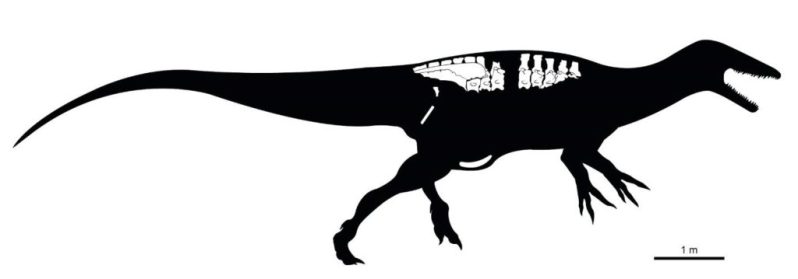Post by dinosauria101 on Apr 23, 2019 3:48:54 GMT 5
Tratyenia rosalesi

Temporal range: Late Cretaceous, 86–83 Ma
Scientific classification
Kingdom: Animalia
Phylum: Chordata
Clade: Dinosauria
Order: Saurischia
Suborder: Theropoda
Clade: †Megaraptora
Family: †Megaraptoridae
Genus: †Tratayenia
Species: †Tratayenia rosalesi Porfiri et al., 2018
Tratayenia is an extinct genus of megaraptoran theropod dinosaur known from remains found in the Bajo de la Carpa Formation in Argentina. The type and only species, Tratayenia rosalesi, was described in March 2018.
The holotype consists of a well-preserved, mostly articulated series of dorsal and sacral vertebrae, two partial dorsal ribs, much of the right ilium, and pubis and ischium fragments.

Discovery and naming
In 2018, some Santonian-aged fossil bones found in the Bajo de la Carpa Formation in Argentina were given the name Tratayenia.
Description
Tratayenia was a medium-sized megaraptoran, growing up to 8 metres (26 ft) long. Like most other megaraptorans, Tratayenia probably had large claws and may have been the geologically youngest megaraptorid or megaraptoran yet discovered. Tratayenia is also the largest-bodied carnivorous animal named from the Bajo de la Carpa Formation, reinforcing the hypothesis that megaraptorids were apex predators in southern South America from the Turonian through the Santonian or early Campanian, following the extinction of carcharodontosaurids.
Tratayenia was related to the more well known Megaraptor.
Classification
Megaraptorans have very controversial relations to other theropods. The first mainstream hypothesis is that they are carnosaurs, distantly related to Allosaurus and more closely related to Neovenator and carcharodontosaurids. The second popular hypothesis considers them to be basal tyrannosauroids, part of the coelurosaur lineage which includes the crested proceratosaurids as well as the famous tyrannosaurids such as Tyrannosaurus. A third hypothesis also considers them to be coelurosaurs, but outside Tyrannosauroidea and basal to practically all other groups of Coelurosauria.
Paleoecology
Tratayenia lived in the Bajo de la Carpa Formation alongside many lizards and turtles, the snake species Dinilysia patagonica, many birds such as Patagopteryx deferrariisi, a diverse amount of crocodylomorphs and many dinosaurs such as Viavenator exxoni and Traukutitan eocaudata.

Temporal range: Late Cretaceous, 86–83 Ma
Scientific classification
Kingdom: Animalia
Phylum: Chordata
Clade: Dinosauria
Order: Saurischia
Suborder: Theropoda
Clade: †Megaraptora
Family: †Megaraptoridae
Genus: †Tratayenia
Species: †Tratayenia rosalesi Porfiri et al., 2018
Tratayenia is an extinct genus of megaraptoran theropod dinosaur known from remains found in the Bajo de la Carpa Formation in Argentina. The type and only species, Tratayenia rosalesi, was described in March 2018.
The holotype consists of a well-preserved, mostly articulated series of dorsal and sacral vertebrae, two partial dorsal ribs, much of the right ilium, and pubis and ischium fragments.

Discovery and naming
In 2018, some Santonian-aged fossil bones found in the Bajo de la Carpa Formation in Argentina were given the name Tratayenia.
Description
Tratayenia was a medium-sized megaraptoran, growing up to 8 metres (26 ft) long. Like most other megaraptorans, Tratayenia probably had large claws and may have been the geologically youngest megaraptorid or megaraptoran yet discovered. Tratayenia is also the largest-bodied carnivorous animal named from the Bajo de la Carpa Formation, reinforcing the hypothesis that megaraptorids were apex predators in southern South America from the Turonian through the Santonian or early Campanian, following the extinction of carcharodontosaurids.
Tratayenia was related to the more well known Megaraptor.
Classification
Megaraptorans have very controversial relations to other theropods. The first mainstream hypothesis is that they are carnosaurs, distantly related to Allosaurus and more closely related to Neovenator and carcharodontosaurids. The second popular hypothesis considers them to be basal tyrannosauroids, part of the coelurosaur lineage which includes the crested proceratosaurids as well as the famous tyrannosaurids such as Tyrannosaurus. A third hypothesis also considers them to be coelurosaurs, but outside Tyrannosauroidea and basal to practically all other groups of Coelurosauria.
Paleoecology
Tratayenia lived in the Bajo de la Carpa Formation alongside many lizards and turtles, the snake species Dinilysia patagonica, many birds such as Patagopteryx deferrariisi, a diverse amount of crocodylomorphs and many dinosaurs such as Viavenator exxoni and Traukutitan eocaudata.


